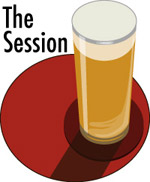 Writing about beer certainly changed my relationship with beer, and made what might look like a simple question next to impossible to answer.
Writing about beer certainly changed my relationship with beer, and made what might look like a simple question next to impossible to answer.
I got to thinking about this because for The Session #15 Boak and Bailey asked those of us in the beer blogosphere to answer this question: How did it all start for you? And going further, “We’d like you to write about the moment when you saw the light.”
Looking over the early posts I’ve been startled that people can single out a beer or a where, because there is no single moment or beer I can point to. From the time going on 40 (gulp) years ago I thought “Hey, there’s something different about this Stroh’s from the the basic what’s-in-the-pitcher beer we’ve been drinking in campus bars” my relationship beer has been evolving. Still is. So across a few decades . . .
1980s, Central Illinois. Schlösser Alt. German bars in the Midwest moved enough beer that we told ourselves it was probably fresh. Dortmunder Union sure had more flavor than American lagers, but then we discovered this alt and bitterness.
1993, a lookout tower north of Mancos, Colorado. New Belgium Abbey Grand Cru. We were still Illinois flatlanders, enjoying a view of four states at 10,000 feet. The beer was brewed with yeast acquired from a Chimay bottle, but it was made nearby.
1994, Lyme Regis (south of England). Five days before a pint of Royal Oak (Eldridge Pope) in Sherbourne had been simply spectacular. This totally living Bass buried it. Bass. A lifeless beer not worth drinking in the States.
All of those experiences occurred separately from writing about beer. But we’ve also trooped into hundreds of brewpubs in the last 20 years, I’ve visited monastery breweries, only scratched the surface with American small-batch brewers and then there are hops . . .
Anyway, I also wouldn’t have been at the last 15 Great American Beer Festivals if I didn’t write about beer. So in October I wouldn’t have had either Cable Car or Toronado 20th Anniversary, brewed and blended by Lost Abbey and Russian River respectively to celebrate Toronado’s anniversary. (Yes, an option would have been to go to Toronado’s party.) One-offs that proved for the hundreth (or is that thousandth?) time that a beer can reveal something no other beer has before.
And no, it doesn’t have to be a new-fangled creation — later this year we’ll be sampling beers in the south of Germany and not much later in the north of Italy, which should be a pretty fun compare and contrast. And no, a beer doesn’t have do that to be great. And yes, perhaps I’m a little dense, but that beer can still surprise me is a joy.
For more Session posts, and perhaps even epiphanies, be sure to see Boak and Bailey’s roundup.
 Funny T-shirt today at
Funny T-shirt today at